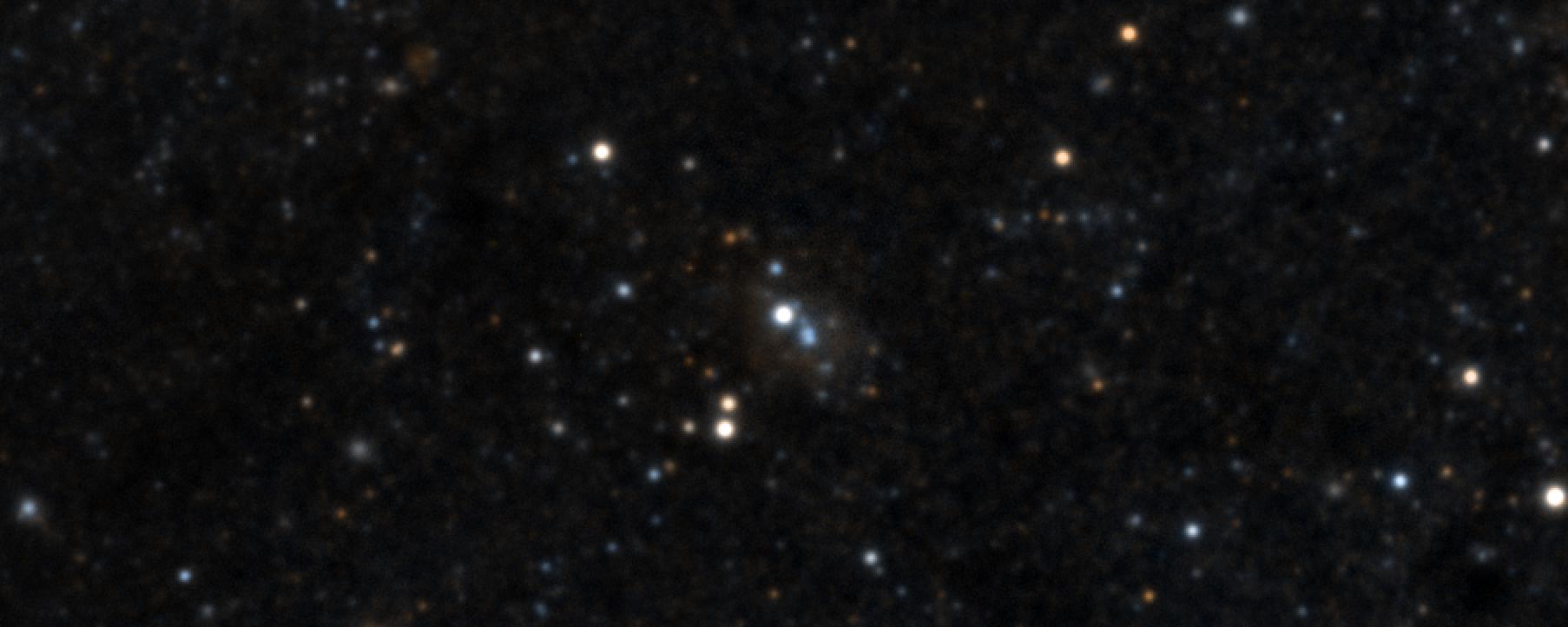M33-013406.63
M33-013406.63 (brightest star at the center) by Pan-STARRS Data Release 1 in blue, g, and r filters. Credit: NASA/UH-IfA | |
| Observation data Epoch J2000.0 Equinox J2000.0 | |
|---|---|
| Constellation | Triangulum |
| Right ascension | 01h 34m 06.63s[1] |
| Declination | +30° 41′ 37.60″[1] |
| Apparent magnitude (V) | 16.1[2] |
| Characteristics | |
| Evolutionary stage | Late O supergiant or candidate LBV[3] |
| Spectral type | O[3] |
| Variable type | cLBV?[3] |
| Astrometry | |
| Absolute magnitude (MV) | –9.1 – –9.6[3] |
| Absolute bolometric magnitude (Mbol) | –12.2 – –12.7[3] |
| Details[2] | |
| A | |
| Radius | 80[a] R☉ |
| Luminosity | 4.68×106 L☉ |
| Temperature | ~30,000 K |
| Rotational velocity (v sin i) | 75±5 km/s |
| B | |
| Radius | 210[b] R☉ |
| Luminosity | 407,380 L☉ |
| Temperature | 10,000 K |
| Other designations | |
LGGS J013406.63+304147.8, B416 | |
| Database references | |
| SIMBAD | data |
M33-013406.63, also known as B416 or UIT301,[4] is a O-type blue evolved supergiant star in the constellation of Triangulum. It is located within the Triangulum Galaxy, which is approximately 2,380,000–3,070,000 light years away from Earth.
It is potentially one of the most luminous stars ever discovered, estimated to be approximately between 3 and 10 million times more luminous than the Sun, although it is thought likely to be a multiple star system.[3] Modelling of the spectrum based on some assumptions about the relative sizes of the two stars suggests a secondary around half a million times as luminous as the Sun and the primary over four million times as luminous as the Sun.[2]
M33-013406.3 is embbed within a prominent ring shaped H II region, large regions of Ionized hydrogen clouds with lots of star formation occurring in them.[5][6] It is also near the center of the H II region its in and possible associated with the nebula's origin.[7]
Notes
- ^ Applying the Stefan-Boltzmann Law with a nominal solar effective temperature of 5,772 K:
- ^ Applying the Stefan-Boltzmann Law with a nominal solar effective temperature of 5,772 K:
References
- ^ a b Van Leeuwen, F. (2007). "Validation of the new Hipparcos reduction". Astronomy and Astrophysics. 474 (2): 653–664. arXiv:0708.1752. Bibcode:2007A&A...474..653V. doi:10.1051/0004-6361:20078357. S2CID 18759600.
- ^ a b c Kourniotis, M.; Kraus, M.; Arias, M. L.; Cidale, L.; Torres, A. F. (2018). "On the evolutionary state of massive stars in transition phases in M33". Monthly Notices of the Royal Astronomical Society. 480 (3): 3706. arXiv:1808.00008. Bibcode:2018MNRAS.480.3706K. doi:10.1093/mnras/sty2087.
- ^ a b c d e f Humphreys, Roberta M.; Weis, Kerstin; Davidson, Kris; Bomans, D. J.; Burggraf, Birgitta (2014). "Luminous and Variable Stars in M31 and M33. II. Luminous Blue Variables, Candidate LBVs, Fe II Emission Line Stars, and Other Supergiants". The Astrophysical Journal. 790 (1): 48. arXiv:1407.2259. Bibcode:2014ApJ...790...48H. doi:10.1088/0004-637X/790/1/48. S2CID 119177378.
- ^ Humphreys, R. M.; Sandage, A. (November 1980). "On the stellar content and structure of the spiral Galaxy M33". The Astrophysical Journal Supplement Series. 44: 319. Bibcode:1980ApJS...44..319H. doi:10.1086/190696. ISSN 0067-0049.
- ^ "H II region | Astronomy, Star Formation & Nebulae | Britannica". www.britannica.com. Retrieved 2023-11-03.
- ^ Peimbert, Manuel; Peimbert, Antonio; Delgado-Inglada, Gloria (2017). "Nebular Spectroscopy: A Guide on H ii Regions and Planetary Nebulae". Publications of the Astronomical Society of the Pacific. 129 (978). arXiv:1705.06323. Bibcode:2017PASP..129h2001P. doi:10.1088/1538-3873/aa72c3.
- ^ Humphreys, Roberta M.; Weis, Kerstin; Davidson, Kris; Bomans, D. J.; Burggraf, Birgitta (2014-07-02). "LUMINOUS AND VARIABLE STARS IN M31 AND M33. II. LUMINOUS BLUE VARIABLES, CANDIDATE LBVs, Fe II EMISSION LINE STARS, AND OTHER SUPERGIANTS". The Astrophysical Journal. 790 (1): 48. arXiv:1407.2259. Bibcode:2014ApJ...790...48H. doi:10.1088/0004-637x/790/1/48. ISSN 0004-637X.



